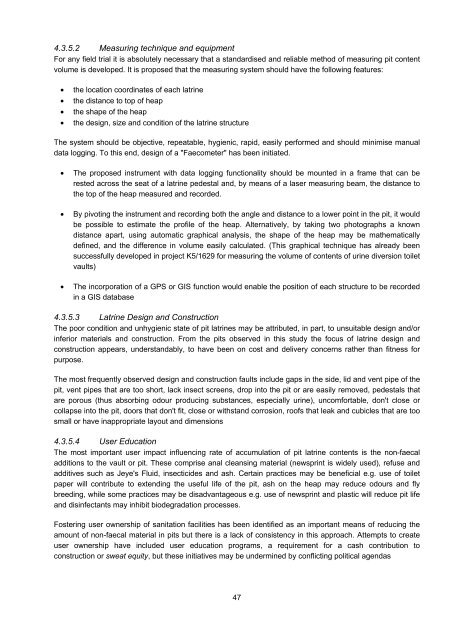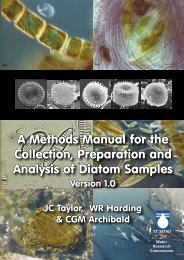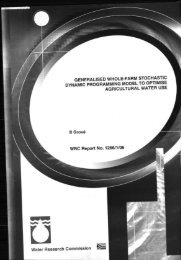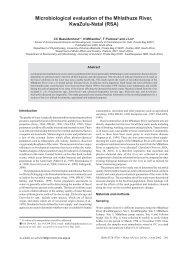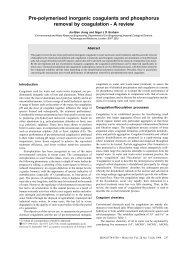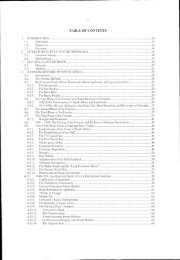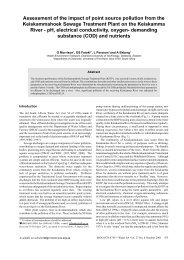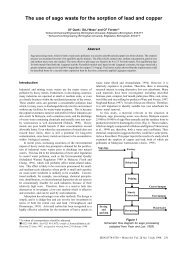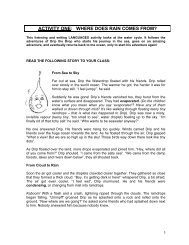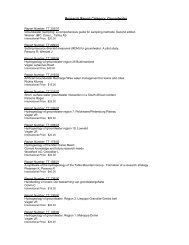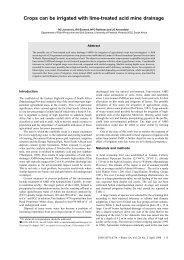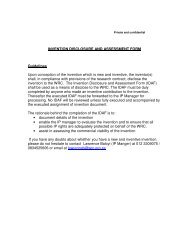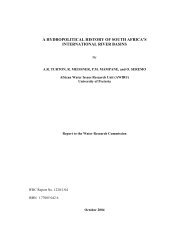and the Efficacy of Pit Latrine Additives - Water Research Commission
and the Efficacy of Pit Latrine Additives - Water Research Commission
and the Efficacy of Pit Latrine Additives - Water Research Commission
- No tags were found...
Create successful ePaper yourself
Turn your PDF publications into a flip-book with our unique Google optimized e-Paper software.
4.3.5.2 Measuring technique <strong>and</strong> equipment<br />
For any field trial it is absolutely necessary that a st<strong>and</strong>ardised <strong>and</strong> reliable method <strong>of</strong> measuring pit content<br />
volume is developed. It is proposed that <strong>the</strong> measuring system should have <strong>the</strong> following features:<br />
<br />
<br />
<br />
<br />
<strong>the</strong> location coordinates <strong>of</strong> each latrine<br />
<strong>the</strong> distance to top <strong>of</strong> heap<br />
<strong>the</strong> shape <strong>of</strong> <strong>the</strong> heap<br />
<strong>the</strong> design, size <strong>and</strong> condition <strong>of</strong> <strong>the</strong> latrine structure<br />
The system should be objective, repeatable, hygienic, rapid, easily performed <strong>and</strong> should minimise manual<br />
data logging. To this end, design <strong>of</strong> a "Faecometer" has been initiated.<br />
<br />
<br />
<br />
The proposed instrument with data logging functionality should be mounted in a frame that can be<br />
rested across <strong>the</strong> seat <strong>of</strong> a latrine pedestal <strong>and</strong>, by means <strong>of</strong> a laser measuring beam, <strong>the</strong> distance to<br />
<strong>the</strong> top <strong>of</strong> <strong>the</strong> heap measured <strong>and</strong> recorded.<br />
By pivoting <strong>the</strong> instrument <strong>and</strong> recording both <strong>the</strong> angle <strong>and</strong> distance to a lower point in <strong>the</strong> pit, it would<br />
be possible to estimate <strong>the</strong> pr<strong>of</strong>ile <strong>of</strong> <strong>the</strong> heap. Alternatively, by taking two photographs a known<br />
distance apart, using automatic graphical analysis, <strong>the</strong> shape <strong>of</strong> <strong>the</strong> heap may be ma<strong>the</strong>matically<br />
defined, <strong>and</strong> <strong>the</strong> difference in volume easily calculated. (This graphical technique has already been<br />
successfully developed in project K5/1629 for measuring <strong>the</strong> volume <strong>of</strong> contents <strong>of</strong> urine diversion toilet<br />
vaults)<br />
The incorporation <strong>of</strong> a GPS or GIS function would enable <strong>the</strong> position <strong>of</strong> each structure to be recorded<br />
in a GIS database<br />
4.3.5.3 <strong>Latrine</strong> Design <strong>and</strong> Construction<br />
The poor condition <strong>and</strong> unhygienic state <strong>of</strong> pit latrines may be attributed, in part, to unsuitable design <strong>and</strong>/or<br />
inferior materials <strong>and</strong> construction. From <strong>the</strong> pits observed in this study <strong>the</strong> focus <strong>of</strong> latrine design <strong>and</strong><br />
construction appears, underst<strong>and</strong>ably, to have been on cost <strong>and</strong> delivery concerns ra<strong>the</strong>r than fitness for<br />
purpose.<br />
The most frequently observed design <strong>and</strong> construction faults include gaps in <strong>the</strong> side, lid <strong>and</strong> vent pipe <strong>of</strong> <strong>the</strong><br />
pit, vent pipes that are too short, lack insect screens, drop into <strong>the</strong> pit or are easily removed, pedestals that<br />
are porous (thus absorbing odour producing substances, especially urine), uncomfortable, don't close or<br />
collapse into <strong>the</strong> pit, doors that don't fit, close or withst<strong>and</strong> corrosion, ro<strong>of</strong>s that leak <strong>and</strong> cubicles that are too<br />
small or have inappropriate layout <strong>and</strong> dimensions<br />
4.3.5.4 User Education<br />
The most important user impact influencing rate <strong>of</strong> accumulation <strong>of</strong> pit latrine contents is <strong>the</strong> non-faecal<br />
additions to <strong>the</strong> vault or pit. These comprise anal cleansing material (newsprint is widely used), refuse <strong>and</strong><br />
additives such as Jeye's Fluid, insecticides <strong>and</strong> ash. Certain practices may be beneficial e.g. use <strong>of</strong> toilet<br />
paper will contribute to extending <strong>the</strong> useful life <strong>of</strong> <strong>the</strong> pit, ash on <strong>the</strong> heap may reduce odours <strong>and</strong> fly<br />
breeding, while some practices may be disadvantageous e.g. use <strong>of</strong> newsprint <strong>and</strong> plastic will reduce pit life<br />
<strong>and</strong> disinfectants may inhibit biodegradation processes.<br />
Fostering user ownership <strong>of</strong> sanitation facilities has been identified as an important means <strong>of</strong> reducing <strong>the</strong><br />
amount <strong>of</strong> non-faecal material in pits but <strong>the</strong>re is a lack <strong>of</strong> consistency in this approach. Attempts to create<br />
user ownership have included user education programs, a requirement for a cash contribution to<br />
construction or sweat equity, but <strong>the</strong>se initiatives may be undermined by conflicting political agendas<br />
47


